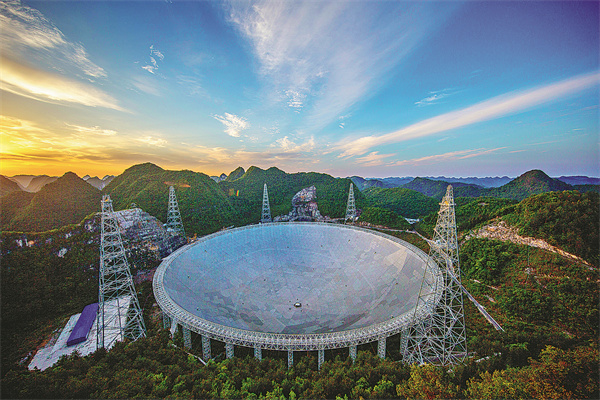Construction begins on FAST core array prototype

Located in a karst depression, FAST, or "China's sky eye", has helped scientists make important scientific research achievements.[Photo provided to China Daily]
In a significant development marking the 8th anniversary of China's Five-hundred-meter Aperture Spherical Radio Telescope, construction officially kicked off on the prototype of the core array for the "China Sky Eye" on Wednesday.
The initiative aims to bolster the telescope's resolution, precise positioning and mapping capabilities, solidifying its position as the world's largest single-dish radio telescope renowned for its unparalleled sensitivity.
Since its completion on Sept 25, 2016, the telescope, also known as FAST, has garnered global acclaim for achieving numerous groundbreaking scientific milestones, as reported by the National Astronomical Observatories of the Chinese Academy of Sciences.
Jiang Peng, deputy director of the National Astronomical Observatories, revealed plans to harness the electromagnetic wave environment within a 5-kilometer radius surrounding FAST. The strategy involves the construction of 24 40-meter aperture radio telescopes to complement FAST and form the core array.
In an interview with China Central Television, Jiang emphasized that the core array's construction will significantly augment the power of the China Sky Eye, as the telescope is also called, expanding its observational reach to distant areas with enhanced clarity.
On Wednesday, a gathering of over 100 experts from domestic research institutions and universities convened in Pingtang county, Guizhou province, home to the FAST facility. The assembly focused on collaborative discussions to strategize the scientific layout and construction blueprint for the FAST core array.
The National Astronomical Observatories outlined that the core array construction plan aims to boost FAST's scientific observation capabilities in a cost-effective way. Anticipated outcomes include groundbreaking advancements in research domains such as the universe's composition and evolution, and the detection of gravitational wave bursts, which may provide new insights for humanity's explorations of the cosmos.
All rights Reserved. 京ICP备13028878号-8







 Overview
Overview Guiyang
Guiyang Guian New Area
Guian New Area Liupanshui
Liupanshui Anshun
Anshun Qianxinan
Qianxinan Qiandongnan
Qiandongnan Qiannan
Qiannan Zunyi
Zunyi Tongren
Tongren Bijie
Bijie Guizhou commits to culture preservation and rural vitalization
Guizhou commits to culture preservation and rural vitalization Guizhou voice at 2025 national two sessions
Guizhou voice at 2025 national two sessions Meet the 'genius moms' at Shenzhen cultural fair
Meet the 'genius moms' at Shenzhen cultural fair 

